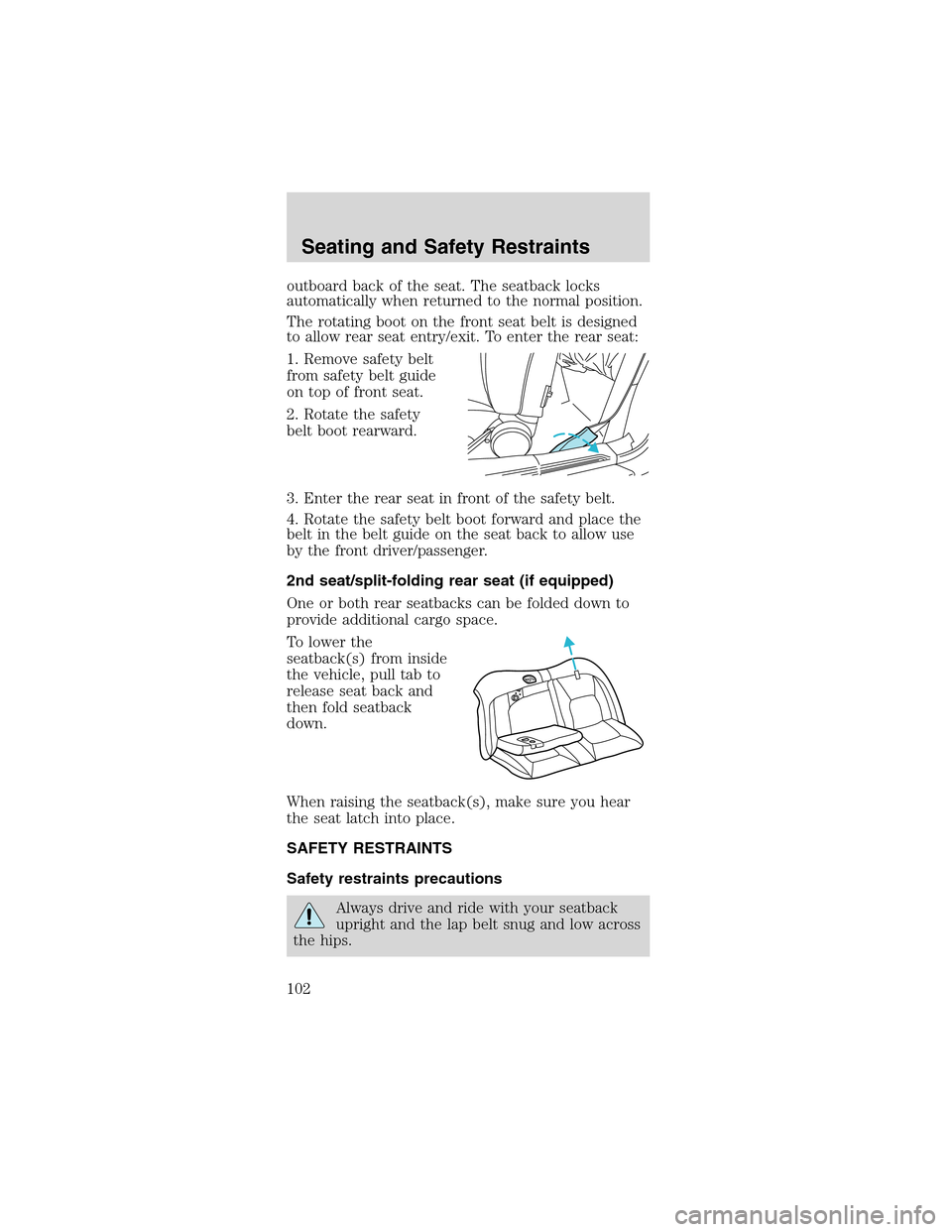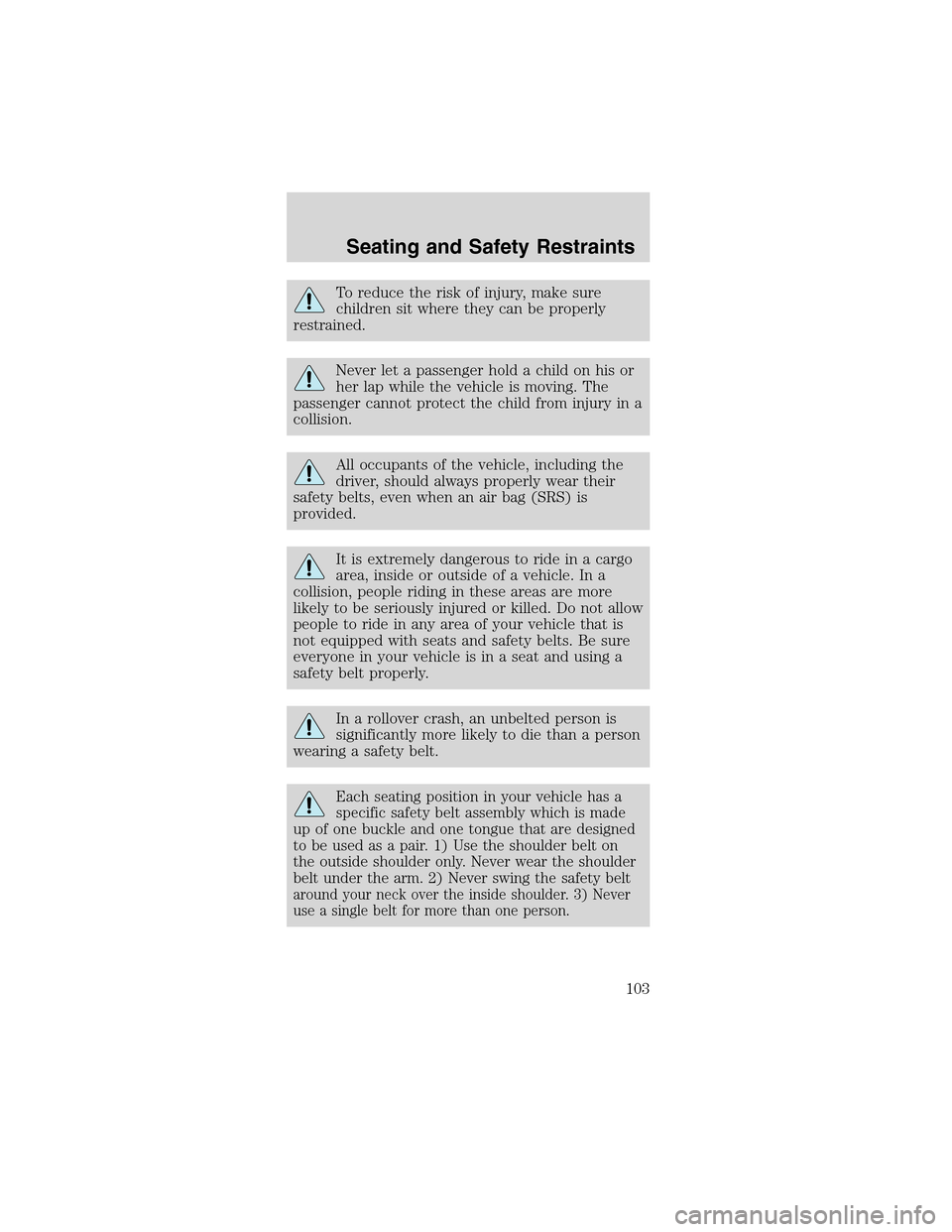Page 8 of 256
These are some of the symbols you may see on your
vehicle.
Vehicle Symbol Glossary
Safety Alert
See Owner’s Guide
Fasten Safety BeltAir Bag-Front
Air Bag-SideChild Seat
Child Seat
Installation WarningChild Seat Tether
Anchorage
Brake SystemAnti-Lock Brake
System
Brake Fluid -
Non-Petroleum
BasedTraction Control
AdvanceTracMaster Lighting
Switch
Hazard Warning
FlasherFog Lamps-Front
Fuse CompartmentFuel Pump Reset
Windshield
Wash/WipeWindshield
Defrost/Demist
Rear Window
Defrost/DemistPower Windows
Front/Rear
Power Window
LockoutChild Safety Door
Lock/Unlock
Introduction
8
Page 10 of 256
WARNING LIGHTS AND CHIMES
Base instrument cluster
Optional instrument cluster
Turn signals
Illuminates when the
turn signals or the
hazard lights are
turned on. If the lights stay on continuously or flash
faster, check for a burned-out bulb.
High beams
Illuminates when the
high beam headlamps
are turned on.
Safety belt
Illuminates to remind
you to fasten your
safety belts. For more
information, refer to
theSeating and safety restraintschapter.
P! BRAKE
L
0
00000 00
C
E
FH
LH
10 203020 406080100
120
140
160
180
405060 70
80
90
100
11 0
1204
5
6
7 3
2
1
H
THEFT
RPMX1000
FUEL DOORSELECT/RESET
LOW
FUELO/D
OFF AIR
BAGSERVICE
ENGINE
SOON
MPH km/h
ABS
.
CHECK
FUEL
CAP
P! BRAKE
L
0
00000 00
C
E
FH
LH
102040608020 40608010 012 0 14 0
160
180
200
220
240
100
120
140
305070 90
110
13 0
1504
5
6
7
8 3
2
1
H
THEFT
RPMX1000
FUEL DOORSELECT/RESET
LOW
FUELO/D
OFF AIR
BAGSERVICE
ENGINE
SOONCHECK
FUEL
CAP
MPH km/h
ABS
.
Instrument Cluster
10
Page 14 of 256

illuminated and parking brake is off. Refer toBrakes
in theDrivingchapter for more information.
Brake system warning
To confirm the brake
system warning light is
functional, it will
momentarily illuminate
when the ignition is turned to the ON position
(alternatively for some vehicles when the ignition is
moved from the ON position to START position, the
light will momentarily illuminate prior to reaching
the START position). It also illuminates if the
parking brake is engaged. If the brake system
warning light does not illuminate as described, seek
service immediately. Illumination after the parking
brake is released indicates low brake fluid level or a
brake system malfunction and the brake system
should be serviced immediately by a qualified
technician. Refer toBrakesin theDrivingchapter
for more information.
Safety belt warning chime
Sounds to remind you to fasten your safety belts.
BeltMinder�chime
Sounds intermittently to remind you to fasten your
safety belts.
Supplemental restraint system (SRS) warning
chime
Sounds when a malfunction in the supplemental
restraint system (front or side airbags) has been
detected. Have the supplemental restraint system
inspected immediately.
Key-in-ignition warning chime
Sounds when the key is left in the ignition and the
driver’s door is opened.
P!
BRAKE
Instrument Cluster
14
Page 99 of 256

SEATING
Adjustable head restraints (if equipped)
Your vehicle’s seats may be equipped with head
restraints which are vertically adjustable. The
purpose of these head restraints is to help limit head
motion in the event of a rear collision. To properly
adjust your head restraints, lift the head restraint so
that it is located directly behind your head or as
close to that position as possible. Refer to the
following to raise and lower the head restraints.
The head restraints can
be moved up and
down.
Adjusting the front manual seat
Never adjust the driver’s seat or seatback
when the vehicle is moving.
Do not pile cargo higher than the seatbacks
to reduce the risk of injuring people in a
collision or sudden stop.
Always drive and ride with your seatback
upright and the lap belt snug and low across
the hips.
Reclining the seatback can cause an
occupant to slide under the seat’s safety
belt, resulting in severe personal injuries in the
event of a collision.
Seating and Safety Restraints
99
Page 100 of 256
Lift handle to move
seat forward or
backward.
Pull lever up to adjust
seatback.
Using the power lumbar support (if equipped)
The power lumbar
control is located on
the outboard side of
the seat.
Press one side of the control to adjust firmness.
Press the other side of the control to adjust
softness.
Adjusting the front power seat (if equipped)
Never adjust the driver’s seat or seatback
when the vehicle is moving.
Do not pile cargo higher than the seatbacks
to avoid injuring people in a collision or
sudden stop.
Always drive and ride with your seatback
upright and the lap belt snug and low across
the hips.
Seating and Safety Restraints
100
Page 101 of 256
Reclining the seatback can cause an
occupant to slide under the seat’s safety
belt, resulting in severe personal injuries in the
event of a collision.
The control is located on the front outboard corner
of the driver’s seat.
Press front to raise or
lower the front portion
of the seat cushion.
Press rear to raise or
lower the rear portion
of the seat cushion.
Press the control to
move the seat forward,
backward, up or down.
REAR SEATS
Use the seatback
release to fold the back
of the front seat
forward for rear seat
passenger entry or exit.
This release handle is
located on the lower
Seating and Safety Restraints
101
Page 102 of 256

outboard back of the seat. The seatback locks
automatically when returned to the normal position.
The rotating boot on the front seat belt is designed
to allow rear seat entry/exit. To enter the rear seat:
1. Remove safety belt
from safety belt guide
on top of front seat.
2. Rotate the safety
belt boot rearward.
3. Enter the rear seat in front of the safety belt.
4. Rotate the safety belt boot forward and place the
belt in the belt guide on the seat back to allow use
by the front driver/passenger.
2nd seat/split-folding rear seat (if equipped)
One or both rear seatbacks can be folded down to
provide additional cargo space.
To lower the
seatback(s) from inside
the vehicle, pull tab to
release seat back and
then fold seatback
down.
When raising the seatback(s), make sure you hear
the seat latch into place.
SAFETY RESTRAINTS
Safety restraints precautions
Always drive and ride with your seatback
upright and the lap belt snug and low across
the hips.
Seating and Safety Restraints
102
Page 103 of 256

To reduce the risk of injury, make sure
children sit where they can be properly
restrained.
Never let a passenger hold a child on his or
her lap while the vehicle is moving. The
passenger cannot protect the child from injury in a
collision.
All occupants of the vehicle, including the
driver, should always properly wear their
safety belts, even when an air bag (SRS) is
provided.
It is extremely dangerous to ride in a cargo
area, inside or outside of a vehicle. In a
collision, people riding in these areas are more
likely to be seriously injured or killed. Do not allow
people to ride in any area of your vehicle that is
not equipped with seats and safety belts. Be sure
everyone in your vehicle is in a seat and using a
safety belt properly.
In a rollover crash, an unbelted person is
significantly more likely to die than a person
wearing a safety belt.
Each seating position in your vehicle has a
specific safety belt assembly which is made
up of one buckle and one tongue that are designed
to be used as a pair. 1) Use the shoulder belt on
the outside shoulder only. Never wear the shoulder
belt under the arm. 2) Never swing the safety belt
around your neck over the inside shoulder. 3) Never
use a single belt for more than one person.
Seating and Safety Restraints
103